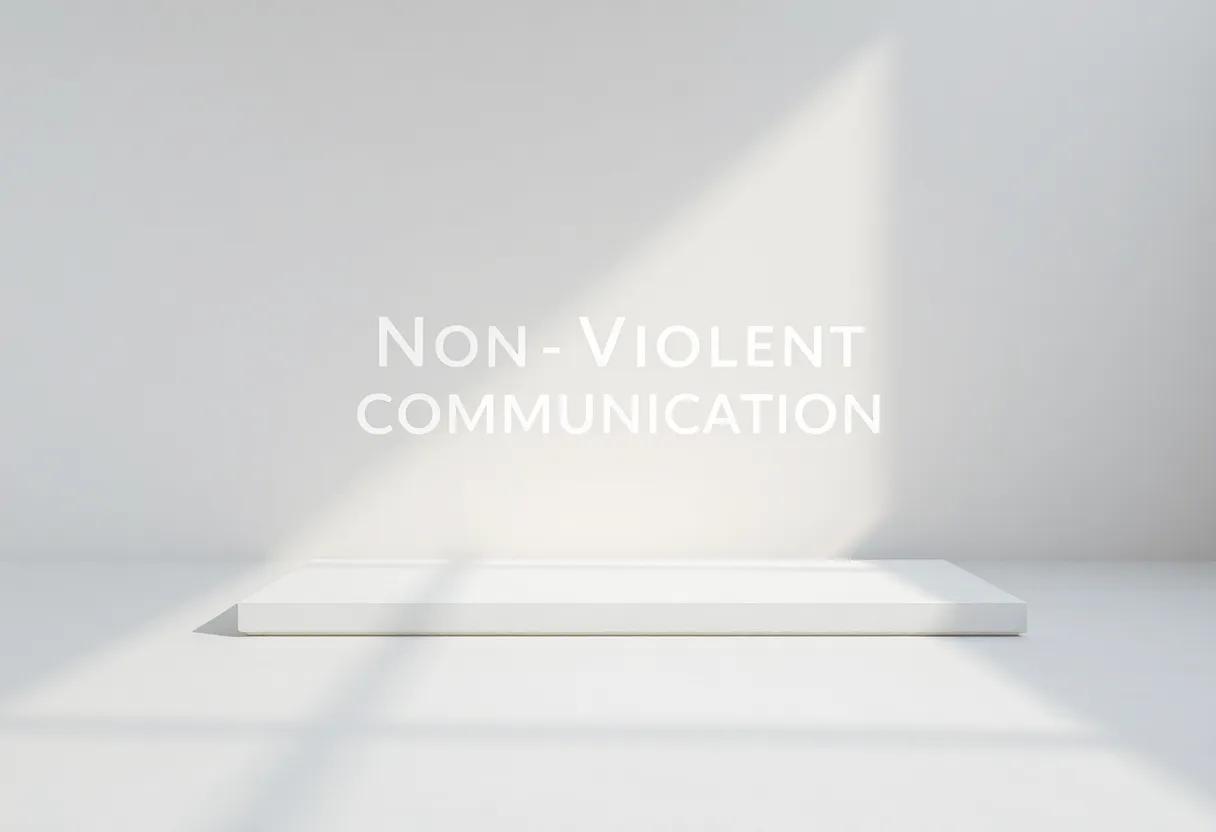In a world often fractured by misunderstanding and conflict,Marshall Rosenberg’s Nonviolent Communication emerges as both a beacon and a bridge-inviting readers to reconnect through empathy and honest expression. embarks on an exploration of this influential work, unraveling its core principles while reflecting on its transformative potential. This review navigates the delicate terrain between theory and practice, inviting readers to consider how Rosenberg’s compassionate approach to dialog might reshape the way we listen, speak, and ultimately relate to one another.
Understanding the Core Principles Behind Rosenberg’s Nonviolent Communication Framework and Its Practical Applications

At the heart of Rosenberg’s framework lies an elegant yet powerful concept: empathy as a bridge. By consciously tuning into our own feelings and needs while genuinely listening to those of others, Nonviolent Communication (NVC) creates a space where understanding flourishes beyond conflict. this process dismantles barriers erected by judgment and blame, replacing them with compassion and clarity. The core components revolve around four key steps: observing without evaluating, expressing feelings, identifying needs, and making heartfelt requests. These pillars foster dialogue that is not only honest but also deeply respectful, encouraging connections rooted in mutual respect rather than competition or fear.
- Observation: Distinguishing facts from interpretations to avoid misunderstandings.
- Feelings: recognizing and expressing emotions without assigning blame.
- Needs: Identifying what is driving emotions to elevate awareness.
- Requests: Clearly and respectfully expressing desires to meet needs.
When applied to real-life situations such as workplace dynamics,family conflicts,or community dialogues,NVC transforms communication into a tool for collaboration rather than contention. The practical nature of this method allows individuals to negotiate challenges with heightened emotional intelligence and reduced defensiveness. Below is a concise comparison illustrating typical reactive communication versus the NVC approach:
| Conventional Reaction | Nonviolent Communication |
|---|---|
| “You never listen to me!” | “I feel unheard when I try to share, and I need connection. Could we try to focus more during our talks?” |
| “Stop being so lazy.” | “I feel overwhelmed when chores pile up, and I need support. Would you help with cleaning this weekend?” |
| “You’re wrong.” | “I see it differently and feel concerned because I value accuracy. Can we explore both views together?” |
Exploring the Role of Empathy in Bridging Emotional Gaps Through Nonviolent Communication Techniques

At the heart of effective communication lies a profound capacity to understand and resonate with the emotions of others.Empathy serves as a bridge over the often turbulent waters of misinterpretation, enabling individuals to connect beyond words. Through the lens of Rosenberg’s Nonviolent Communication (NVC), empathy is not merely a passive feeling but an active skill that guides one to listen deeply and respond thoughtfully. It transforms dialogues from confrontations into collaborative explorations, where feelings and needs are recognized without judgment or blame.
The practical application of empathy in NVC unfolds through several key techniques:
- Observing without evaluating: Distinguishing pure facts from interpretations helps maintain clarity and reduces defensiveness.
- Identifying feelings: Naming emotions openly fosters authenticity and invites vulnerability.
- Expressing Needs: Highlighting underlying human needs connects the dialogue to global human experiences.
- Making Requests: Framing clear,positive actions encourages cooperation rather than resistance.
| Empathy Element | Role in Bridging Gaps |
|---|---|
| Observation | Clarifies reality, minimizes assumptions |
| Feeling Identification | Promotes emotional honesty |
| Need Recognition | Unites participants on common ground |
| Request Articulation | Encourages mutual understanding |
How Rosenberg’s Approach Transforms Conflict Resolution in Personal and Professional Relationships

At the core of Rosenberg’s method lies an elegant simplicity that reshapes the way people navigate conflicts by prioritizing empathetic connection and authentic expression. Instead of resorting to blame or criticism, this approach encourages individuals to listen actively and articulate their feelings and needs honestly, which fosters mutual understanding. This paradigm shift allows both parties to step out of defensive postures and engage in a dialogue that honors vulnerability and respect. Whether in a bustling corporate boardroom or a quiet living room, this gentle yet powerful technique turns discord into opportunities for deeper connection and collaboration.
The beauty of Rosenberg’s framework is that it equips everyone with practical tools to diffuse tension and build trust. Elements like paraphrasing, identifying underlying needs, and making clear, compassionate requests become foundational skills that not only resolve conflicts swiftly but cultivate lasting emotional intelligence. Below is a rapid reference table summarizing key components and their transformative effects:
| Component | Role in Conflict Resolution | Impact |
|---|---|---|
| Observations | Neutral, fact-based statements | Prevents misinterpretations and defensiveness |
| Feelings | Expressing emotions authentically | Encourages openness and empathy |
| Needs | Identifying core human desires | Creates clarity and common ground |
| Requests | Making reachable, clear asks | Facilitates collaborative solutions |
- Reduces misunderstandings by focusing on shared human experiences rather than conflicting positions.
- Empowers individuals to express themselves without fear of judgment or retaliation.
- Builds resilience in relationships by transforming disagreements into growth opportunities.
The Impact of Language Choice on Building Connection and Trust in Rosenberg’s Communication model

Language serves not just as a vehicle for information but as the very foundation upon which genuine connections are built in Rosenberg’s Communication Model. By choosing words that reflect empathy, clarity, and respect, speakers invite openness and vulnerability, encouraging others to respond in kind. Instead of defaulting to accusatory or judgmental phrases, this approach promotes expressions grounded in personal feelings and universal human needs. The intentional shift from blame to understanding creates a fertile ground for trust to flourish, transforming conversations from potential conflicts into collaborative problem-solving experiences.
Consider how subtle variations in phrasing drastically alter the emotional landscape in dialogues:
| Typical Phrase | NVC-Inspired Choice | effect on Connection |
|---|---|---|
| “You never listen to me!” | “I feel unheard when I can’t share my thoughts.” | Invites empathy, lowers defensiveness |
| “You’re being selfish.” | “I notice a need for consideration in this moment.” | Encourages reflection, fosters respect |
| “Stop interrupting.” | “I need a moment to finish my point.” | Maintains dignity, supports cooperation |
- Clarity: Expressing what is truly felt and needed avoids confusion.
- Vulnerability: Revealing emotions opens pathways to authenticity.
- Respect: Honoring both parties’ experiences nurtures mutual trust.
Ultimately, the thoughtful choice of language acts as a bridge-turning barriers into bonds, and skepticism into security. It demonstrates that communication is not merely about exchanging words but about nurturing the shared humanity that underpins every meaningful relationship.
Balancing Honesty and Compassion When Expressing Needs and Feelings Effectively

Mastering the delicate dance between truthfulness and kindness is at the heart of fostering genuine connection. When articulating our needs and feelings, the challenge lies not in mere transparency but in framing honesty with empathy. By acknowledging our inner experiences without blame or judgment,we invite others into a space of understanding rather than defensiveness. This nuanced balance requires tuning into our own vulnerabilities while honoring the emotional landscapes of those we communicate with, creating a bridge rather than a barrier.
Practically, this can be nurtured by integrating simple yet profound practices:
- Use “I” statements: Express thoughts and emotions from your perspective to avoid sounding accusatory.
- Focus on specific behaviors: Describe actions rather than attributing intent, which can reduce misunderstandings.
- Validate feelings: Recognize and reflect the emotions behind the words,showing you value the other’s experience.
- Mindful pacing: Allow pauses and space for the conversation to breathe, preventing emotional overwhelm.
| Technique | Purpose | Impact |
|---|---|---|
| Observing Without Evaluating | Separate facts from judgments | Prevents blame, fosters clarity |
| Expressing Needs Clearly | Identify what matters to you | encourages cooperation |
| Empathetic Listening | Understand the other’s feelings | Builds trust and safety |
Critical Analysis of Key Exercises and Real-Life Scenarios Presented in the Book for Skill Development
Rosenberg’s approach shines through its practical exercises, each meticulously designed to embed the principles of empathy and honesty into everyday communication. These exercises don’t merely teach a skill-they invite readers into a transformative journey where the abstract notions of connection become tactile and real. As an example, role-playing scenarios where participants articulate their feelings without blame challenge users to recalibrate deep-seated conversational habits. This dynamic gives rise to a more conscious dialogue,emphasizing introspection alongside outward expression. The subtle distinctions Rosenberg cultivates between requests and demands come alive vividly through these activities, fostering an surroundings of mutual respect and authentic listening.
What sets these real-life examples apart is their broad applicability, stretching across personal conflicts, workplace tensions, and even social movements. Rosenberg’s use of everyday conflicts-from family disagreements to professional misunderstandings-underscores the universal nature of his communication model.To illustrate this, consider the following simplified table that categorizes the exercises based on context and intended skill development:
| Context | Exercise Focus | Key skill Developed |
|---|---|---|
| Family | Expressing Needs Clearly | Emotional Honesty |
| Workplace | Active Listening Practice | Empathetic Engagement |
| Social Settings | Transforming Criticism | Nonjudgmental Interaction |
Comparing Nonviolent Communication to Traditional Communication Methods in Modern Society
In the fabric of everyday interactions,traditional communication often leans heavily on transactional exchanges-requests,commands,and occasionally,expressions of frustration or disagreement. This method, while efficient for passing information, can inadvertently foster misunderstandings due to its tendency to emphasize judgment and reaction rather than connection. Conversely,the approach energized by Rosenberg’s beliefs pivots towards a language of empathy and vulnerability,encouraging individuals to articulate their feelings and needs without blame or demand. This subtle yet profound shift fosters a space where dialogue is not a battleground but a bridge. The contrast is not simply in style but in the underlying intention: one prioritizes winning or convincing; the other prioritizes understanding and collaborative resolution.
To visualize this distinction, consider the table below illustrating core features often found in each method. Notice how nonviolent communication focuses on self-awareness and mutual respect, whereas traditional communication frequently underscores hierarchy and persuasion:
| Aspect | Traditional Communication | Nonviolent Communication |
|---|---|---|
| Focus | Information transfer & persuasion | Understanding feelings & needs |
| Tone | Often assertive or defensive | Empathetic and collaborative |
| goal | Winning the point or task completion | Mutual understanding & connection |
Embracing this compassionate approach in modern society can transform routine conversations into opportunities for deeper emotional exchange. The ripple effect? Stronger relationships, reduced conflicts, and a culture that values human dignity above mere rhetoric. As we navigate increasingly complex social landscapes, adopting language that bridges hearts rather than walls becomes not just preferable, but essential.
Practical recommendations for Integrating Nonviolent Communication Practices Into Daily Life Challenges
Embedding nonviolent communication into everyday interactions requires more than understanding its principles-it demands intentional practice. Start by cultivating active listening, not just hearing words but uncovering the emotions and unmet needs beneath them. When tensions arise, pause to breathe and reflect before responding, allowing space for empathy rather than reactivity. Replacing judgmental language with observations free of evaluation helps soften difficult conversations and opens the door for genuine connection. Simple phrases like “I feel…” and “I need…” become powerful tools, fostering transparency and mutual respect even in the busiest moments.
Consider incorporating small rituals that reinforce compassionate communication, such as a daily check-in with yourself or loved ones to share feelings and needs without interruption. Use visual reminders-sticky notes, phone alarms, or a dedicated journal-to stay mindful of key NVC tenets. Below is a quick reference table to guide practical steps during common challenges:
| Situation | Recommended NVC Practice | Example Phrase |
|---|---|---|
| Disagreement at Work | Express feelings & needs clearly | “I feel concerned as I need clarity on the project goals.” |
| Family Misunderstanding | Listen empathetically without interruptions | “It sounds like you’re feeling overwhelmed; is that right?” |
| Self-criticism | Offer self-compassion & acknowledge needs | “I’m noticing frustration-I need patience with myself.” |
Assessing the Book’s Accessibility and suitability for Diverse Audiences and Cultural Contexts
Rosenberg’s work is crafted with a universal appeal, yet it is indeed his ability to adapt core principles to varied cultural landscapes that truly sets this book apart. The language employed is clear and accessible, intentionally avoiding jargon, which encourages readers from multiple backgrounds to engage without feeling alienated. Key concepts are illustrated with relatable examples-ranging from workplace conflicts to family dynamics-that resonate across diverse social settings. This thoughtful approach ensures the book serves as an effective guide for individuals, educators, and organizations striving to foster empathy and understanding in their unique environments.
However, while the foundational ideas maintain their relevance, the book’s one-size-fits-all structure occasionally overlooks nuances intrinsic to specific cultures. Such as, expressions of emotion and conflict resolution vary widely worldwide, influencing how nonviolent communication might be received or practiced. Considering this, the book encourages readers to:
- Adapt the communication strategies to fit cultural norms without diluting the core message.
- reflect on local customs around hierarchy,directness,and emotional expression.
- Engage in community dialogues to contextualize and personalize the principles.
| Audience | Accessibility | Cultural Sensitivity |
|---|---|---|
| Educators | High – Practical frameworks included | Moderate - Requires cultural tailoring |
| Corporate Leaders | Moderate – Some formal language | Moderate - Inclusive but context-dependent |
| General Readers | High – Engaging and straightforward | Variable – Depends on cultural lens |
The Use of Storytelling and Case Studies to Illustrate the power of Nonviolent Communication
Marshall Rosenberg’s use of storytelling breathes life into the abstract principles of Nonviolent communication (NVC),transforming theory into relatable human experiences.By weaving vivid anecdotes from diverse contexts-family disputes, workplace tensions, or community conflicts-he invites readers to witness how empathy becomes a bridge rather than a barrier. These narratives don’t simply show *what* to do; they reveal *why* it matters, making the emotional stakes tangible and the lessons unforgettable. His approach underscores that communication is not just an exchange of words, but a shared journey toward mutual understanding and connection.
Complementing storytelling,rosenberg’s case studies serve as practical blueprints for applying NVC in real-life scenarios.They offer readers a clear, step-by-step glimpse into the dynamics of conflict resolution, emphasizing key components such as:
- Observation without judgment
- Expressing feelings clearly
- Identifying underlying needs
- Making requests that foster collaboration
| Scenario | Conflict | NVC Strategy |
|---|---|---|
| Office team meeting | Misunderstood deadlines causing stress | expressing feelings and clarifying needs for support |
| parent-child interaction | Resistance to homework completion | Requesting understanding and empathy rather than demands |
| Neighborhood disagreement | Noise complaints escalating tension | Observing without blame and offering collaborative solutions |
By dissecting these real-world encounters, readers gain confidence in embracing NVC principles, seeing clearly how compassion can transform even the most entrenched conflicts into opportunities for connection.
How Bridging Hearts Encourages Self-Awareness and Emotional Intelligence Through Reflective Practices
at its core, Bridging Hearts fosters self-awareness by inviting individuals to slow down and consciously engage with their inner emotional landscape. Through guided reflective practices, participants learn to recognize subtle feelings and untangle the often complex web of thoughts and judgments that cloud genuine emotional clarity. This heightened self-awareness acts as a compass, orienting people toward authenticity and vulnerability, key ingredients in nurturing empathetic connections.The emphasis on pausing, observing, and naming emotions gently shifts communication away from reactive patterns and toward thoughtful expression.
These reflective exercises also serve as a fertile ground for cultivating emotional intelligence. By intentionally pausing to identify not only one’s own needs but also the unspoken needs of others, individuals develop a more nuanced understanding of interpersonal dynamics. The practice incorporates simple yet powerful techniques such as journaling feelings, engaging in mindful dialogues, and using empathetic listening-all designed to deepen emotional literacy. Below is a snapshot of some core reflective tools used within Bridging Hearts to empower this journey:
| Reflective Tool | Purpose | Outcome |
|---|---|---|
| Emotional Journaling | Identify and articulate feelings | Clarity & emotional release |
| Mindful Pause | Interrupt reactive responses | Increased presence & calm |
| Empathetic Listening | Understand others’ emotions | Deeper connection & trust |
| Needs mapping | Link feelings to unmet needs | Root-cause awareness |
The Book’s Contribution to Contemporary Dialogue on Peacebuilding and Social Change Strategies
Rosenberg’s work transcends traditional boundaries of communication by infusing empathy and mutual understanding into the very fabric of peacebuilding. His approach challenges prevailing adversarial models, offering rather a toolkit that prioritizes connection over confrontation.This paradigm shift invites practitioners and activists alike to explore dialogue as a transformative act, where listening becomes an active bridge, enabling communities divided by entrenched conflicts to rediscover common humanity. Through nonviolent Communication (NVC),the book illuminates pathways that not only mitigate violence but actively cultivate a culture of compassionate exchange,deeply relevant in today’s fractured global landscape.
In contemporary social change strategies, the principles outlined serve as a flexible yet profound framework, adaptable across diverse contexts – from grassroots movements to international diplomacy. Consider the following key aspects that the book highlights as crucial in fostering sustainable peace:
- Empathy as a Core Skill: Transforming adversarial dialogue into opportunities for genuine understanding.
- Needs-Based Language: Shifting conversations from blame to shared human needs.
- Active Listening Techniques: Promoting inclusivity and validating perspectives that are often marginalized.
| Strategy | Impact |
|---|---|
| Dialogue Facilitation | Breaks Down Barriers |
| Conflict De-escalation | Reduces Hostility |
| Collaborative Problem Solving | Builds Trust Networks |
About Marshall Rosenberg The Visionary Behind Nonviolent Communication and his Lasting Legacy
marshall Rosenberg was more than a psychologist-he was a catalyst for transforming how we connect with one another on a essential level. His pioneering work in developing Nonviolent Communication (NVC) emerged from a deep desire to foster empathy, understanding, and peace in everyday interactions. Rooted in a profound respect for human needs and emotions, Rosenberg’s vision challenged traditional patterns of conflict that often escalate misunderstanding and hostility. Through his teachings, countless individuals and communities worldwide have learned to bridge divides by communicating with authenticity and compassion, creating spaces where real connection flourishes.
His legacy is not just a method but a movement that continues to inspire change across multiple arenas-from education and corporate environments to international diplomacy. The core principles of NVC emphasize:
- Observing without judging to better understand situations without bias.
- Expressing feelings openly to nurture emotional honesty.
- Identifying universal needs to transcend differences and find common ground.
- Making clear, compassionate requests that invite cooperation rather than resistance.
His approach offers a timeless framework for healing discord and building meaningful connections, proving that even simple shifts in language can pave the way toward harmony and mutual respect.
Bridging Hearts serves not only as a thoughtful exploration of Rosenberg’s principles but also as an invitation-to listen more deeply, to speak more kindly, and to connect more meaningfully. Whether you’re new to Nonviolent Communication or seeking to deepen your practice, this review offers a steady compass guiding you through the heart of empathy and understanding. As the pages close, the conversation begins anew, reminding us that every bridge built with intention has the power to transform the spaces between us.








